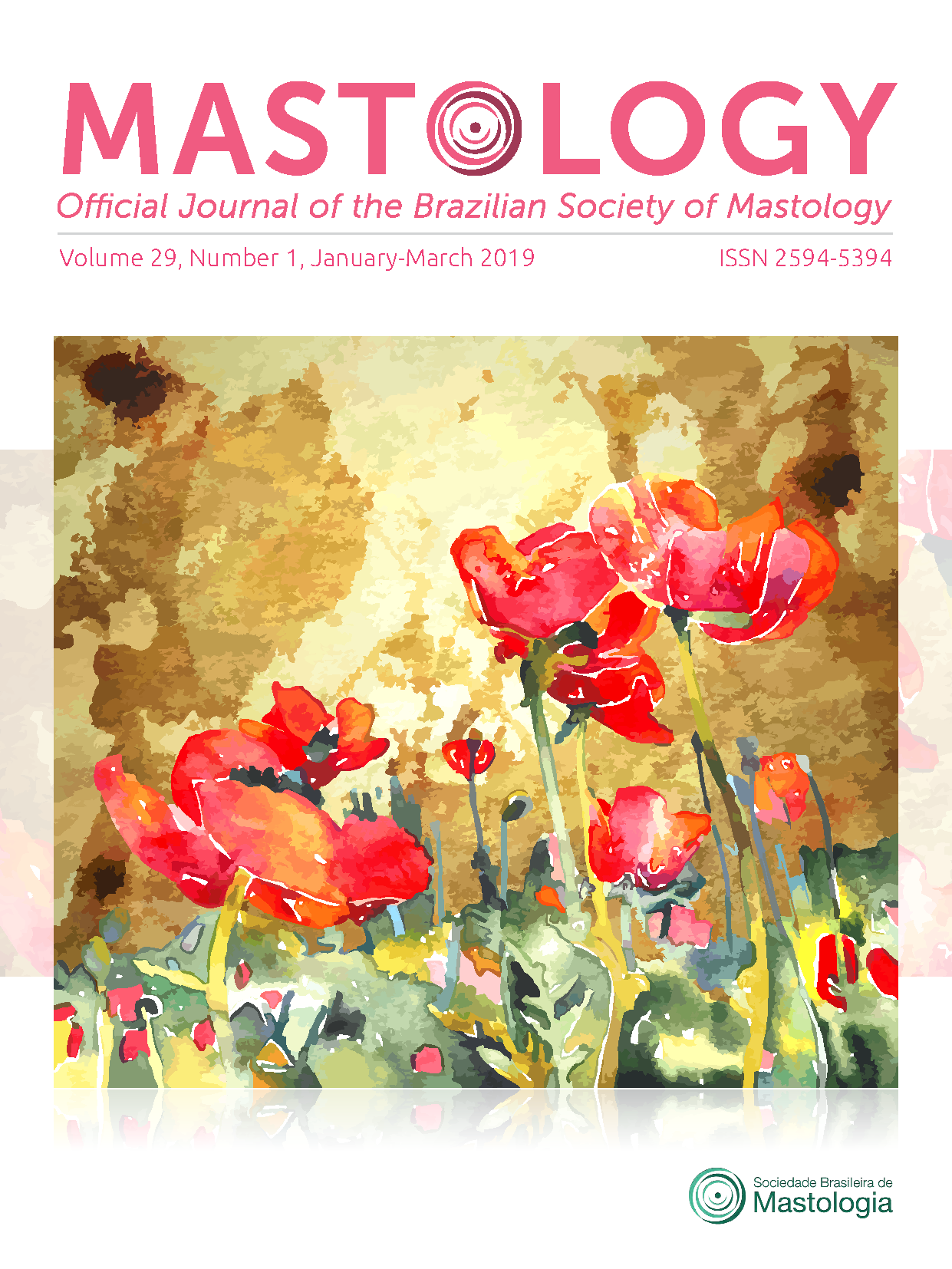Avaliação da recidiva local da cirurgia conservadora de mama no Instituto do Câncer do Ceará
Palavras-chave:
Carcinoma ductal de mama, mastectomia segmentar, recidivaResumo
Introdução: O câncer de mama é o tumor maligno que mais acomete mulheres em todo o mundo, excetuando-se os casos de pele não melanoma. No Brasil, estimavam-se mais de 56.000 casos para 2016. A mortalidade esperada ainda é alta devido ao diagnóstico tardio. Na atualidade, a cirurgia conservadora é o padrão-ouro. Objetivo: Avaliar a recidiva locorregional da cirurgia conservadora praticada no Instituto do Câncer do Ceará, no período entre 2002 a 2012. Método: Estudo transversal e descritivo, utilizando dados secundários obtidos nos prontuários médicos de pacientes com câncer de mama operadas no Instituto do Câncer do Ceará. Resultados: A população em estudo foi de 360 pacientes. O carcinoma ductal invasivo foi o tipo mais comum (72,8%), seguido do carcinoma ductal in situ (16,4%) e do carcinoma lobular invasivo (4,7%). Os outros tipos histológicos representam 6,4% (cribiforme, 0,5%; medular, 0,6%; microinvasor, 0,3%; mucinosos, 1,1%; papilífero, 3,1%; e tubular, 0,8%). Na amostra, 25 pacientes tiveram algum tipo de recidiva: 13/360 (3,6%), local ou locorregional; e 12/360 (3,3%), recidiva a distância. Conclusão: Da análise dos dados, podemos concluir que a cirurgia conservadora praticada no Instituto do Câncer do Ceará tem dados de recorrência compatíveis com a literatura internacional.
Downloads
Referências
Instituto Nacional do Cancer Jose Alencar Gomes da Silva. Estimativa, 2016: Incidencia de Cancer no Brasil. Rio de Janeiro: Inca; 2016.
Halsted WS. The results of radical operations for the cure of carcinoma of the breast. Ann Surg. 1907;46(1):1-19.
Fisher B, Montague E, Redmond C, Deutsch M, Brown GR, Zauber A, et al. Findings from NSABP Protocol No. B-04 - comparison of radical mastectomy with alternative treatments for primary breast cancer. I. Radiation compliance and its relation to treatment outcome. Cancer. 1980;46(1):1-13. https://doi.org/10.1002/1097-0142(19800701)46:1%3C1::AIDCNCR2820460102%3E3.0.CO;2-3
Fisher ER, Anderson S, Redmond C, Fisher B. Ipsilateral breast tumor recurrence and survival following lumpectomy and irradiation: patological findnes from NSABP protocol B-06. Semin Surg Oncol. 1992;8(3):161-6.
Veronesi U, Cascinelli N, Mariani L, Greco M, Saccozzi R, Luini A, et al. Twenty-year follow-up of a randomized study comparing breast-conserving surgery with radical mastectomy for early breast cancer. N Engl J Med. 2002;347(16):1227-32. https://doi.org/10.1056/NEJMoa020989
Harlow SP, Krag DN, Julian TB, Ashikaga T, Weaver DL, Feldman SA, et al. Prerandomization surgical training for the NSABP – 32 trial: a randomized phase III clinical trial to comparari sentinel node ressection to conventional axilary disseccion in clinically node – negative breast cancer. Ann Surg. 2005;241(1):48-54.
Bhatti AB, Khan A, Muzaffar N, Siddiqui N, Syed A, Shah M, et al. Safe negative margin width in breast conservative therapy: results from a population whit a high percentage of negative prognostic factors. World J Surg. 2014;38(11):2863-70. https://doi.org/10.1007/s00268-014-2651-7
Van Laan C, Van der Sangen MJ, Poortmans PM, Nieuwenhuijzen GA, Roukema JA, Roumen RM, et al. Local recurrence following breast conserving treatment in women aged 40 years or younger: trends in risk and impact on prognosis in a population – based cohort of 1143 patients. Eur J Cancer. 2013;49(15):3093-101. https://doi.org/10.1016/j.ejca.2013.05.030
Munck L, Schaapveld M, Siesling S, Wesseling J, Voogd AC, Tjan-Heijnen VCG, et al. Implementation of trastuzumab in conjunction with adjuvante chemotherapy in the treatment of non-metastatic breast cancer in the Netherlands. Breast Cancer Res Treat. 2011;129(1):229-33. https://doi.org/10.1007/s10549-011-1451-0
van Dongen JA1, Voogd AC, Fentiman IS, Legrand C, Sylvester RJ, Tong D, et al. Long-term results of a randomized trial comparing breast-conserving therapy with mastectomy: European Organization for Research and Treatment of Cancer 10801 trial. J Natl Cancer Inst. 2000;92(14):1143-50.
National Comprehensive Cancer Network. Portal [Internet]. Filadelfia: National Comprehensive Cancer Network; 2014. Disponivel em: http://www.nccn.org/
Coates AS, Winer EP, Goldhirsch A, Gelber RD, Gnant M, Piccart-Gebhart M, et al. Tailoring therapies-improving the management of early breast cancer: St Gallen International Expert Consensus on the Primary Therapy of Early Breast Cancer 2015. Ann Oncol. 2015;26(8):1533-46. https://doi.org/10.1093/annonc/mdv221
Greenberg CC, Habel LA, Hughes ME, Nekhlyudov L, Achacoso N, Acton L, et al. Characterization and treatment of local recurrence following breast conservation for ductal carcinoma in situ. Ann Surg Oncol. 2014; 21(12):3766-73. https://doi.org/10.1245/s10434-014-3802-7
Downloads
Publicado
Como Citar
Edição
Seção
Licença
Copyright (c) 2019 Giovanni de Freitas Magalhães, Francisco Pimentel Cavalcante, Marcos Venício Alves Lima, Rafael Bustamante de Castro

Este trabalho está licenciado sob uma licença Creative Commons Attribution 4.0 International License.







